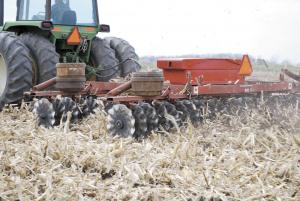They Built Their Own Residue Buster
 ✖  |
No-till farmer Marvin Burkhart and his son, Kim, built their own residue buster for $3,000 - about a tenth of what a new piece of equipment would have cost. It's not quite as good as a purchased one, they say, but for the price they can live with it.
The Burkharts have no-till farmed in Leaf River, Ill., for 30 years and have no desire to farm any other way, but with BT corn they've noticed the stalks are tougher and don't break down as well.
"With corn on corn, there can be more disease and fungus problems if there's a lot of residue. It takes its toll on the next year's crop," Kim says.
They had looked at vertical tillage equipment, which helps break up residue. But with only 300 acres of corn, it didn't make sense for the Burkharts to buy an expensive new tool.
"We had this 18-ft. disk sitting in the shed," Marvin says, and he and his son decided to revamp it.
The Burkharts completely disassembled the disk, put in new bearings, straightened the gangs, and replaced the blades with 1-in. wave blades. They staggered the 48 gangs so the rows are 4 1/2 in. apart.
"Our biggest challenge was to come up with enough weight to get penetration," Kim says. They placed an old toolbox on the frame and filled it with 3,500 lbs. of tractor weights. The weight made it bow so they added 300-lb. semi brake drums on each wing. The drums are bolted to the frame and can be removed when the disk is folded up.
The Burkharts tested the tillage buster for the first time last spring, and it penetrated the soil 2 in.
"We did see improvement breaking up the residue, but we can see some of the old rows behind our disk," Kim says.
His neighbor's Case IH vertical tillage tool chewed up more residue, left a nicer seedbed and pulled up root balls. The neighbor's corn was 10 bushels higher per acre and a 1-point drier. However, the tillage tool created more compaction.
Overall, the Burkharts were pleased with how their homemade residue buster helped decompose the stalks by last fall. This spring, they planned to add another technique - adding 2 lbs. of sugar per acre with a stalk digester - to help speed up decomposition.
They also planned to beef up weak areas of the disk where they noticed stress cracks due to the weights that were added to the machinery to make it penetrate in the soil.
Contact: FARM SHOW Followup, Marvin Burkhart, 1748 W. Lightsville Rd., Leaf River, Ill. 61047 (ph 815 757-7260).

Click here to download page story appeared in.
Click here to read entire issue
They Built Their Own Residue Buster TILLAGE EUIPMENT Miscellaneous 34-3-27 No-till farmer Marvin Burkhart and his son, Kim, built their own residue buster for $3,000 - about a tenth of what a new piece of equipment would have cost. It's not quite as good as a purchased one, they say, but for the price they can live with it.
The Burkharts have no-till farmed in Leaf River, Ill., for 30 years and have no desire to farm any other way, but with BT corn they've noticed the stalks are tougher and don't break down as well.
"With corn on corn, there can be more disease and fungus problems if there's a lot of residue. It takes its toll on the next year's crop," Kim says.
They had looked at vertical tillage equipment, which helps break up residue. But with only 300 acres of corn, it didn't make sense for the Burkharts to buy an expensive new tool.
"We had this 18-ft. disk sitting in the shed," Marvin says, and he and his son decided to revamp it.
The Burkharts completely disassembled the disk, put in new bearings, straightened the gangs, and replaced the blades with 1-in. wave blades. They staggered the 48 gangs so the rows are 4 1/2 in. apart.
"Our biggest challenge was to come up with enough weight to get penetration," Kim says. They placed an old toolbox on the frame and filled it with 3,500 lbs. of tractor weights. The weight made it bow so they added 300-lb. semi brake drums on each wing. The drums are bolted to the frame and can be removed when the disk is folded up.
The Burkharts tested the tillage buster for the first time last spring, and it penetrated the soil 2 in.
"We did see improvement breaking up the residue, but we can see some of the old rows behind our disk," Kim says.
His neighbor's Case IH vertical tillage tool chewed up more residue, left a nicer seedbed and pulled up root balls. The neighbor's corn was 10 bushels higher per acre and a 1-point drier. However, the tillage tool created more compaction.
Overall, the Burkharts were pleased with how their homemade residue buster helped decompose the stalks by last fall. This spring, they planned to add another technique - adding 2 lbs. of sugar per acre with a stalk digester - to help speed up decomposition.
They also planned to beef up weak areas of the disk where they noticed stress cracks due to the weights that were added to the machinery to make it penetrate in the soil.
Contact: FARM SHOW Followup, Marvin Burkhart, 1748 W. Lightsville Rd., Leaf River, Ill. 61047 (ph 815 757-7260).
To read the rest of this story, download this issue below or click
here to register with your account number.







